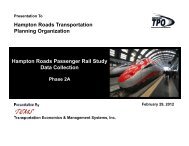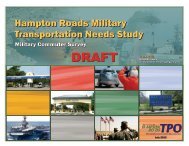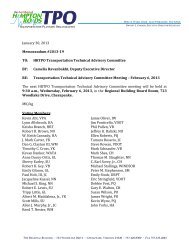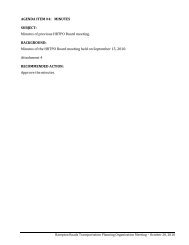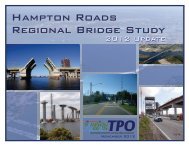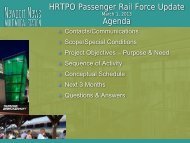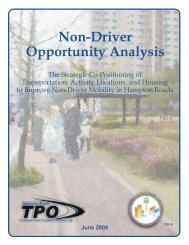Submitted Public Comments - Hampton Roads Transportation ...
Submitted Public Comments - Hampton Roads Transportation ...
Submitted Public Comments - Hampton Roads Transportation ...
You also want an ePaper? Increase the reach of your titles
YUMPU automatically turns print PDFs into web optimized ePapers that Google loves.
Virginia language does not sufficiently recognize or support the state’s MPO<br />
organizations (this is especially unfortunate for the HRTPO, the largest MPO wholly in<br />
Virginia); (2) the state’s maintenance of two statewide <strong>Transportation</strong> Programs (STIP<br />
and SYIP) is confusing; it diminishes the role of regional MPOs in the programming<br />
process; it diminishes the value of the HRTPO’s TIP development efforts; it appears to<br />
be over costly to maintain two separate Programming documents; and is not adequately<br />
adherent to the intent of federal regulations. As supporting information, four<br />
documents are attached:<br />
a. JLARC Final Audit Report, <strong>Transportation</strong> Planning and Programming<br />
b. JLARC Audit, Agency Responses<br />
c. Overall JLARC Recommendations‐1<br />
d. MPO Point Paper 2009‐14, The STIP and the SYIP<br />
2. The Governor’s Letter of Designation of the HRTPO. The Governor’s letter of<br />
designation of the HRTPO needs to be updated (U.S.C. 23 CFR 450.310 refers). As<br />
supporting information, two documents are attached:<br />
a. Past history and continued need to issue updated Governor letters of<br />
Designation for HRTPO<br />
b. Currently effective HRTPO Designation letters<br />
3. The federally required Annual Obligations Report (AOR). Recommend new<br />
attention be paid to the statewide and the regional procedures being used to develop<br />
the Annual Obligations Report (23CFR450.332 Annual listing of obligated projects<br />
refers). This is the ultimate performance measure – did you effectively spend obligated<br />
dollars provided, or do you need to improve your sequencing of projects, find better<br />
ways to fill the project pipeline, introduce increased discipline to avoid parking funds<br />
on projects that are not or cannot advance, etc.? Because of unintelligible VDOT<br />
information provided by the state, some MPOs in Virginia have refused to post their<br />
AOR in the past. At present, the HRTPO’s AOR is posted for public review, but it<br />
contains so many unanswered questions, that it is useless. I believe that this is a major<br />
issue, one that if corrected, however, would bring great visibility, integrity and<br />
efficiency to the statewide and regional programming process, and it would be a<br />
corrective action that could finally enable all MPOs in Virginia to not be afraid of this<br />
AOR document and to begin to use it as the ultimate self‐measurement of programming<br />
efficiency. And, a new process could be developed that would be adherent to federal<br />
regulations as concerns the AOR. The text that is currently posted before the HRTPO<br />
AOR document makes the point—that text follows in italics below.<br />
HRTPO staff received the Virginia Department of Rail and <strong>Public</strong> <strong>Transportation</strong><br />
(DRPT) portion of the Annual Obligation Report on October 12, 2011. HRTPO staff<br />
reviewed the information submitted by DRPT and found no issues.<br />
HRTPO staff received the Virginia Department of <strong>Transportation</strong> (VDOT) portion of<br />
the Annual Obligation Report on November 29, 2011. HRTPO staff reviewed the<br />
information submitted by VDOT and compiled a list of issues that have been forwarded<br />
to VDOT for comment/resolution. In the interim, HRTPO staff posted the Annual<br />
Obligation Report on the HRTPO website on December 21, 2011, using the information<br />
2



